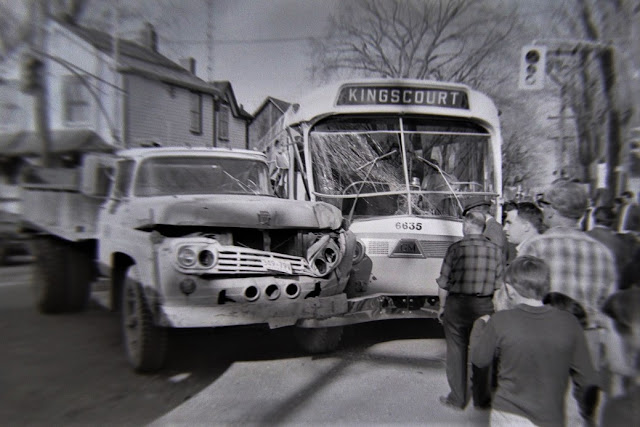I occasionally come across city bus photos. There are not many such photos, so it's always a neat find to come across one. With the demise of the Kingston electric railway, Kingston City Coach, a subsidiary of Colonial Bus Lines, operated city bus service from 1930 until July 1, 1962. Thereafter, buses were operated by the Kingston Public Transit System (KPTS). The KPTS moniker was chosen in May, 1962 and the system transferred to the the Public Utilities Commission at the end of 1962. The system was later renamed Kingston Transit (KT). Bus 5609 (a 1952 Canadian Car & Foundry product, originally owned by Kingston City Coach) operating as a school bus at Lasalle Causeway, with Orefax tied up in background on January 15, 1968 (top photo).
Though not evident in the black & white archival photos, the Kingston buses wore an attractive white and light-blue paint scheme, still reflected in today's fleet. This online auction site photo shows bus 6223 operating on the Montreal route (note green flag) and passing St Andrew's Presbyterian Church at Princess and Barrie Streets:
Buses 6216-6230 were the first new buses ordered by KPTS, entering service in October, 1962. Four of the buses were parked at the Cricket Field, in front of the Frontenac Country Court House for their publicity photos by George Lilley, one of which was included in a Whig ad on October 3, 1962 advertising free rides!
6222 on Princess Street, 1966 (below)
Waiting buses at Brock & King Streets, 1965:
New bus orders continued, all from General Motors for their 35-foot 'New Look' models, totalling ten orders over the next 14 years, before orders were placed for higher capacity, 40-foot GM models. 6434 at Brock and King in 1966:
New GM 'fishbowls', 1968:
Interior and exterior views during an industrial site tour, 1967:
Exterior and interior views of the downtown bus barns, 1968:
6532 outside the bus barns, 1965
Through slush at the Traffic Circle, KT 6737 in January, 1969:KT 6635 at Pine and Division tussle with truck, April 1969:
Sharin' the road - 6333 with a snowmobile during snowy April, 1969:More photos from the transition era. November 17, 1969 near City Hall:
(All photos in this post from Queen's University Archives)
.JPG)


.JPG)






















The colour photo is interesting, especially wit the centennial logo on the front. What is the purpose of the green flag?
ReplyDeleteThere were so few bus routes in Kingston that even into the 1980's, each one had its own colour flag. I can remember Division/Calvin Park was orange, Kingscourt/Polson Park was blue, plus there were red, green and brown ones for other routes.
ReplyDeleteThanks for your question and comment, Eric.
Eric
Red was Hillendale/Strathcona Park, green was Montreal/Regent-Johnson and brown was Barriefield. I also remember a purple flag Queen Mary Rd. route in the late '60s-very early '70s. You're correct on the blue and orange flags.
ReplyDeleteThanks very much for that additional information, Stu!
ReplyDeleteEric
A long time practise of Kingston Transit and its predecessors, evident in all these photos, is their year-based bus fleet numbering system. The first two digits are the year the bus was manufactured, and the last two are a sequential series starting from when they adopted this system. This gives an easy indication of how old the bus is. The first bus in your post, 5609, would have been built in 1956 and was the ninth bus since they started the numbering scheme. Once the last two digits got to 99 the next bus started the series again at 00 (this occurred in the late 1990s I believe). It works well, as long as they never own more than 100 buses at any one time.
ReplyDeleteThe system was not quite perfect as there were several buses that had the first two digits changed over the years. The fifteen buses 5601-5615 were actually built in 1952 for Provincial Transportation but were rebuilt with a rear exit door in 1956 when sent to Kingston.
DeleteThat was very true, Scott. Things got a little askew in some of the recent orders which were not numbered sequentially, alternating between 15- to 19-series. We had 1506 and 2106, for instance. The year prefix has always been correct re: delivery date, though.
ReplyDeleteThanks for your comment,
Eric
Years ago I researched the history of transit in Kingston and came up with quite a few photographs of old buses. I was also lucky enough to speak to some of the original drivers, sadly since passed on, and had planned to write a book on the subject, which never happened due to other issues. There were some interesting details such as the 1962 TGH-3102 (6216-6230) were built for a system in California but ended up in Kingston to replace a batch of leased Old Looks that KPTS had taken over from KCC but did not want, due to their advanced age.
ReplyDelete